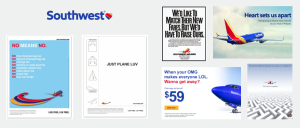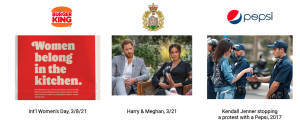Can a celebrity drive awareness for your brand? Consider the power of Kim Kardashian and SKIMs, Ryan Reynolds and Aviation Gin or Calvin Klein and Justin Bieber.

celebrity & brands
Brands have been working with talent for decades for a simple reason: it works. When done correctly, celebrities can drive deeper awareness for your product and boost your brand’s visibility to a wider audience. But done incorrectly, you’ll spend more money than you ever imagined and people will remember your talent, but not your product.
For brand strategists and marketers, it’s a tricky formula to get right. Here’s how to avoid major pitfalls.
Why use a celebrity?
Celebrity endorsement, aka celebrity branding or celebrity advertising, is the practice of using a celebrity and their image to promote a brand, product or cause. This can help drive sales in the short term and brand awareness in the long term. It can also set you apart from your competitors in a highly competitive market. It’s also an effective strategy if you’re marking a major change for your brand – like the introduction of a new product, market expansion, or brand repositioning. For instance, when Nike expanded from track and tennis into other sports like basketball, they partnered with NBA star Michael Jordan to create & market several new product lines, which resulted in explosive growth for the brand.
So it’s definitely an effective marketing lever to pull if your brand is ready for that kind of awareness and growth.
But there are a few watch-outs to take into account when it comes to dealing with talent.
Can Talent Overshadow Your Brand?
Advertising legend David Ogilvy once famously said he would never work with celebrities and brands because “people remember the celebrity and not the product.” He’s not wrong. Brands routinely shell out millions for a celebrity endorsement, and the star gets the limelight while the brand becomes a side prop. As an example, Tiffany’s recent Lose Yourself in Love campaign stars Beyonce. The ads do a wonderful job of celebrating the singer and her role in modern culture, but the association to Tiffany and their product is vague.
How can you avoid this pitfall? It requires being intentional up front about the role of your brand in relation to the role of the talent. If you don’t define your brand as the Hero of the story, your talent will engulf any brand aspect, overshadowing the outcome.
Several brands have successfully navigated celebrity overshadowing. Some recent examples:
- This Apple spot heroes Apple’s music service with an utterly distracted Taylor Swift.
- This Barilla pasta spot stars Roger Federer, but he’s getting put through the paces. The hero of this story? Italian cooking is masterful with Barilla pasta.
- And Intimissimi features Heidi and Leni Klum but the product and the company’s Italian heritage is the hero of the spot (disclosure: Magnetic Brand Strategy worked on this campaign).
When navigating campaigns with talent, always remember that your brand is the star, and your celebrity is the spotlight. The best way to ensure this is to have a clear story line, where the talent’s role in the campaign is to support the brand – see the examples above – they don’t outshine the brand.
Important as well, you also want a well designed story line that brings out the authenticity of the brand in relation to the celebrity’s life. If the connection between the brand and talent feels authentic (like Taylor Swift organically using Apple Music, or Heidi Klum wearing elegant Italian lingerie), it will make your efforts more effective.
Other Hiccups to Consider: Overexposure, Scandal
Big celebrities come with big followings but often also a smorgasbord of other endorsement deals. We recommend to avoid this type of celebrity. Consumers are crazy and they realize when they’re being sold to and when the celebrity is being bought. So it’s important to choose a celebrity carefully – choose one that is organically aligned with your brand. Would they use your product naturally? Would they pay for your brand’s product themselves? Also, the celebrity that endorses all brands endorses none. Don’t gravitate to someone just because of their (potentially inflated) Instagram following. Choose wisely. It’s better to go with a lesser-known celebrity who is passionate about your brand than an A-lister who is simply bankrolling endorsements.
As well, people love a good celebrity scandal, but not when it comes to your brand. Inappropriate behavior can negatively influence your brand image, so again, find talent that best reflects your brand organically and choose your talent wisely.
How to use Celebrity
There are a few ways your brand can use celebrity to endorse your product or service:
Celebrity ads and commercials – These are banners and videos for paid campaigns on social media (Instagram, TikTok, YouTube). You can also purchase commercial slots on television. In taking this step you’ll want to partner with a media agency to ensure your campaign gets maximum visibility.
Celebrity signature product lines – some brands put a celebrity name or face directly on their product (think Kaia Gerber and Zara; or Lizzo and FABletics), or increasingly, celebrities are launching their own lines (think Kourtney Kardashian with Poosh; George Clooney with 3 Amigos Tequila; and many others). This is quite popular amongst celebrities because they can negotiate t0 get a percentage of sales in addition to visibility.
Celebrity appearances in live events – brands often invite a celebrity to present a keynote or to host an event on their behalf – think Gary Vaynerchuk and Tony Robbins. This is a good approach if your event is large enough and the celebrity has a strong relevant connection to your brand, event and audience.
Celebrity spokesperson – Celebrity spokesperson advertising is common in the not-for-profit sector and causes. The celebrity does the work of bringing attention to a cause while speaking on behalf of the organization at third-party events and to the media.
Is celebrity right for your brand, and is your business ready for that kind of exposure? We covered a lot of cursory information in this post. If you want to learn more, reach out to us for a chat. We’re happy to consult and give you our expert opinion on if it will make your brand magnetic to success.




